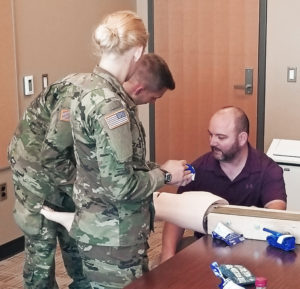by Patricia Deal, CRDAMC Public Affairs
FORT HOOD (Now designated Fort Cavazos), Texas—When it comes to saving victims of life-threatening illnesses and injuries, emergency medicine technicians and first-responders need to know what to do and be able to do it quickly.
Carl R. Darnall Army Medical Center ensures its emergency medicine services personnel are educated and experienced in the latest evidence-based treatment techniques that will help preserve life and limb. With its offering of several resuscitative medicine and pre-hospital trauma treatment courses, CRDAMC makes it convenient and cost-effective for its emergency medicine professionals to complete their required recertification and mandatory training.
“In the last two years we’ve gone from teaching about five or six courses to teaching about 16 courses in the different facets of trauma and emergency medicine. We’re basically a one-stop shop for our medics and EMTs. We looked at what they needed and then came up with a plan so we can take care of our personnel,” said Pedro Perez, a nurse and training instructor.
The courses are designed to meet the certification and education standards of the National Association for Emergency Medical Technicians and the mandatory recertification and training requirements for Army combat medics.
“By bringing these courses in-house, we’ve saved time and money. A couple of years ago the NAEMT redid how it does its recertification. EMTs were going offsite and paying quite a bit of money to an outside entity in order to achieve recertification,” said Jonathan Strand, an EMT and training instructor. “We determined that it would be cost-effective for us to add these particular courses to our curriculum. We’re already providing training on other emergency medicine applications, and we already have the equipment and other training tools required for the pre-hospital courses. Plus we have access to a state-of-the-art simulation lab. We’ve saved money without sacrificing the quality of the training our EMS folks receive.”
The costs associated with EMT recertification can be in the hundreds of thousands of dollars, Perez said, adding that they have been able to greatly curtail that dollar amount required for recertification and continuing education credits by bringing those courses in-house.
“Just as an example, the Pre-hospital Trauma Life Support certification course out in the civilian world could cost upwards of $450. For CRDAMC staff, they get the same standard of training, and it’s only going to cost them $10 for the certification card,” he added.
Another benefit of offering the NAEMT certifications courses is that they help ensure Army medics are certified and trained in the skills required to save lives on or off the battlefield. The NAEMT courses afford the medic an opportunity to communicate their competence and professionalism in terms the civilian workforce can understand.
“The standard ‘Table 8’ certifications that the 68Ws (medics) have to complete per their military occupation standard don’t really translate well as applicable job experience when applying for a civilian position as an EMT. But our six NAEMT certifications do, and by completing all of them, it can give that medic an edge over other applicants out there,” Strand said.
To become a designated training site for the specialized certification courses, CRDAMC had to be evaluated and approved by the NAEMT. Once Strand and Perez became certified as NAEMT affiliate faculty, they could expand their program by training others to be instructors.
“We take advantage of our assets in-house as much as possible. We’ve trained some of our EMS personnel to be instructors thus increasing our training capability. Also, by certifying specific physicians as instructors we’ve been able to add additional specialized courses such as Geriatric Education for EMS which is taught by CRDAMC’s geriatrician,” Strand said.
Strand added that they are also certified to teach NAEMT’s two-day tactical combat casualty care course and its sister Tactical Emergency Casualty Care course for civilians. Once the curriculum for those courses is finalized, Strand said they will be added to the schedule.
They also plan to offer new courses such as Disaster Relief, EMS safety and Stop the Bleeding.
“The Stop the Bleeding course is great training to add to your readiness checklist. It is designed to teach everyone—not just medical personnel—to be able help save lives of victims of accidents or mass casualty events by identifying life threatening bleeding and then stop it either by applying a tourniquet or pressure dressing as needed,” Perez said. “It’s a critical skill that could make the difference between life and death for victims before EMS arrives on scene.”










